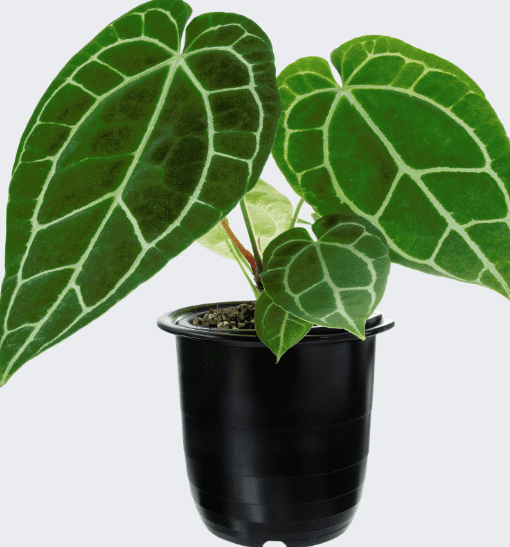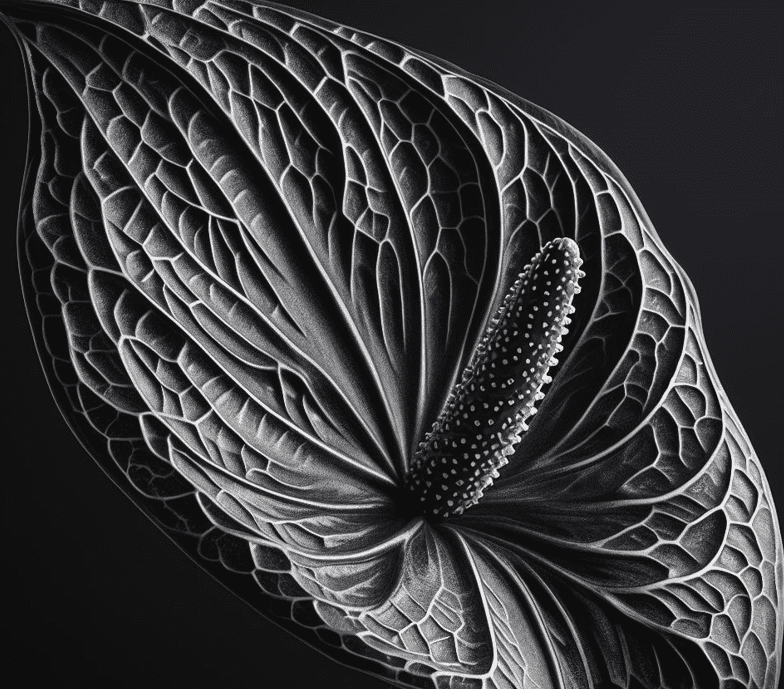Have You Ever Dreamed of a Plant That Resembles a Crystal?
Imagine a plant that purifies the air and adds a touch of exotic elegance to your home. Meet the Anthurium crystallinum, a tropical marvel with stunning foliage that captivates at first glance.
Background of the Crystal Laceleaf
Originating from the rainforests of Central and South America, the Anthurium crystallinum, commonly known as the Crystal Laceleaf, is a botanical wonder. Its heart-shaped leaves with crystal-like veins have made it a favorite among rare plant collectors.
How to Care for Anthurium Crystallinum
Creating the Perfect Environment
Light and Soil
The Crystal Anthurium thrives in bright, indirect light and well-draining soil. A mix of orchid bark, perlite, and peat moss creates an ideal environment for its roots.
Water, Temperature, and Humidity
Regular watering, maintaining a temperature of 65-75°F (18-24°C), and high humidity are crucial. Overwatering can lead to root rot, so ensure the soil is moist but not soggy.
Maintenance Tips for a Healthy Plant
Fertilizing and Pruning
Fertilize monthly during the growing season with a balanced, water-soluble fertilizer. Pruning old or yellowing leaves encourages new growth and maintains the plant’s aesthetic appeal.
Cleaning the Leaves
Gently wipe the leaves with a damp cloth to remove dust. This improves the plant’s appearance and enhances its ability to photosynthesize.

How to Propagate Anthurium Crystallinum
Propagation Methods: Division and Stem Cuttings
Division
Divide the plant during repotting by gently separating the roots. This method is ideal for mature plants and ensures a quicker establishment of the new plant.
Stem Cuttings
Choose a healthy stem with at least two nodes. Plant it in a moist, well-draining medium and maintain high humidity for optimal root development.
Maximizing Propagation Success
Tips for Thriving Cuttings
Use rooting hormone to enhance root growth and cover the pot with a plastic bag to create a mini-greenhouse effect.
How to Troubleshoot Anthurium Crystallinum
Identifying and Managing Pests and Diseases
Common Foes: Spider Mites and Aphids
Look out for tiny webs or sticky leaves indicative of spider mites and aphids. Regularly inspect your plant and treat infestations promptly with insecticidal soap or neem oil.
Fungal Infections: Prevention and Cure
Overwatering can lead to fungal issues. Ensure good air circulation and avoid wetting the leaves to prevent fungal growth.
Recognizing Signs of Distress
Yellowing Leaves and Root Rot
Yellow leaves can indicate overwatering or nutrient deficiency. Check the roots for rot, which appears as black, mushy roots, and adjust your watering schedule accordingly.

Final Word: Mastering Anthurium Crystallinum Care
Embracing the Heart-Shaped Wonder
The Anthurium crystallinum, with its distinctive heart-shaped leaves, is more than just a plant; it’s a piece of South America in your home. This crystal anthurium, a gem among tropical plants, thrives in a carefully crafted environment that mimics its natural habitat.
The Key to Perfect Humidity and Light
Maintaining the right humidity levels is crucial for this tropical beauty. The Anthurium crystallinum’s heart-shaped leaves flourish in humidity like their native rainforests. When it comes to lighting, indirect light is your best friend. Protect your plant from direct sunlight to prevent the leaves from scorching.
Soil Mix: The Foundation of Health
A well-draining soil mix, rich in peat moss, ensures your Anthurium crystallinum roots remain healthy. This soil composition prevents the dreaded root rot, a common issue in less ideal conditions.
Propagation: Expanding Your Anthurium Family
Propagation through stem cuttings is a quick and effective way to multiply your collection. Whether you’re adding to your houseplant ensemble or planning to stock your view cart with Anthurium crystallinum for sale, propagation is a rewarding experience.
Temperature: The Warmth They Need
These plants prefer a cozy environment, thriving in temperatures around 65-75 degrees Fahrenheit. This warmth and the right soil and water balance create an ideal setting for mature plants and new stem cuttings.
Indoor Care: A Guide to Thriving Houseplants
Anthurium crystallinum indoor care involves balancing water, light, and humidity. Overwatering can be as harmful as under-watering, so ensure the soil is moist but not waterlogged. Remember, these plants are more forgiving with less water than with more.
Addressing Common Issues
Brown spots on Anthurium leaves can indicate water stress or a pest problem. Regular checks and prompt action can keep your plant healthy and vibrant.
The Joy of Anthurium Crystallinum Flowers
While known for its leaves, the Anthurium crystallinum flower is a delightful surprise, adding an extra layer of beauty to this already stunning plant.
Anthurium Crystallinum Care: A Rewarding Journey
Whether looking at the Anthurium crystallinum size for a small space or considering the Anthurium crystallinum price for your next purchase, remember that the care you give makes the difference. This care guide is your first step towards becoming an Anthurium crystallinum expert.
The Crystal Anthurium: A Jewel in Your Plant Collection
In conclusion, whether you’re a seasoned gardener or a budding enthusiast, the Anthurium crystallinum, with its unique crystallinum care needs and captivating appearance, is a must-have. Embrace the journey of nurturing this exquisite plant and enjoy the lush, tropical vibe it brings to your home.



























